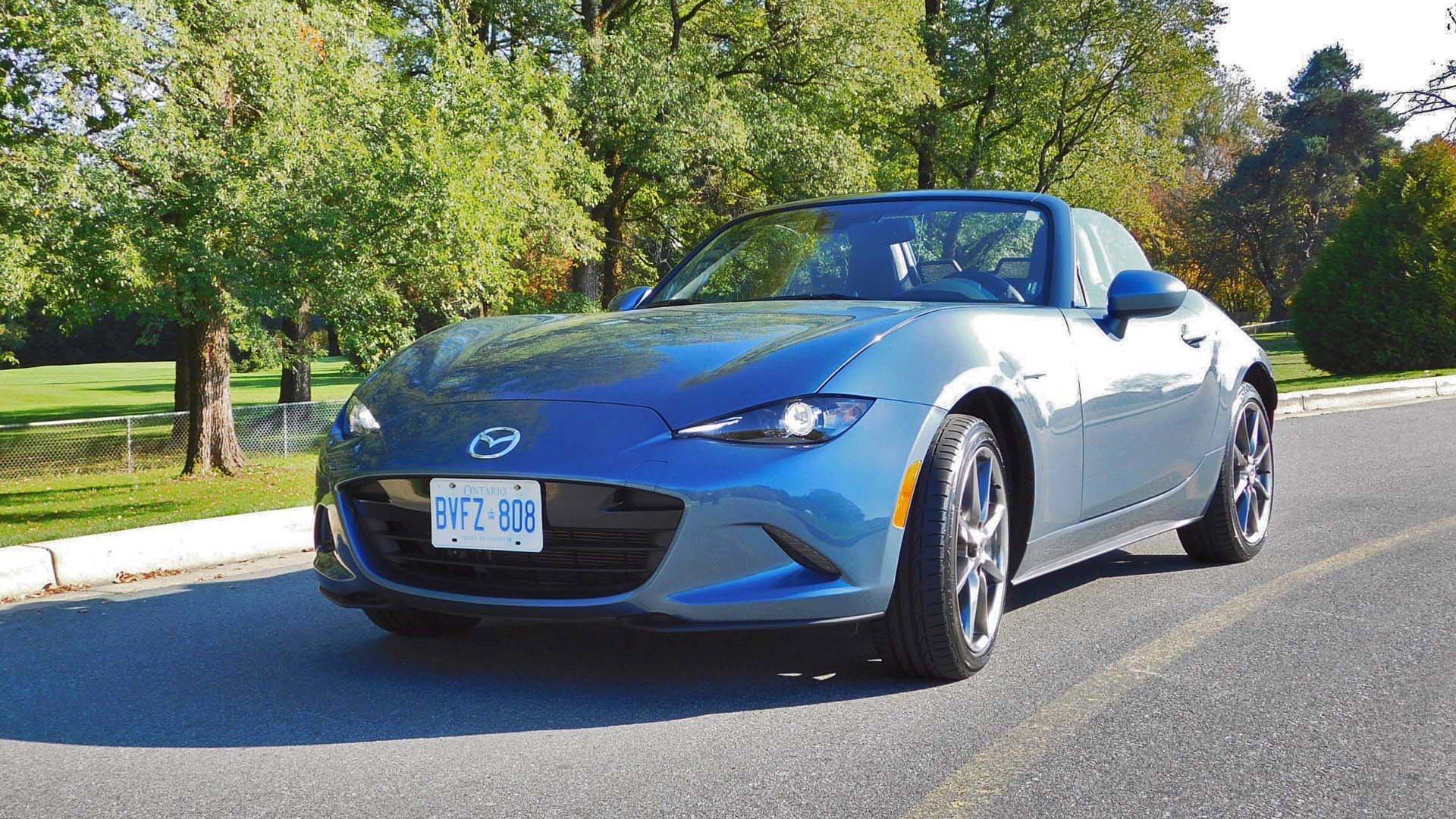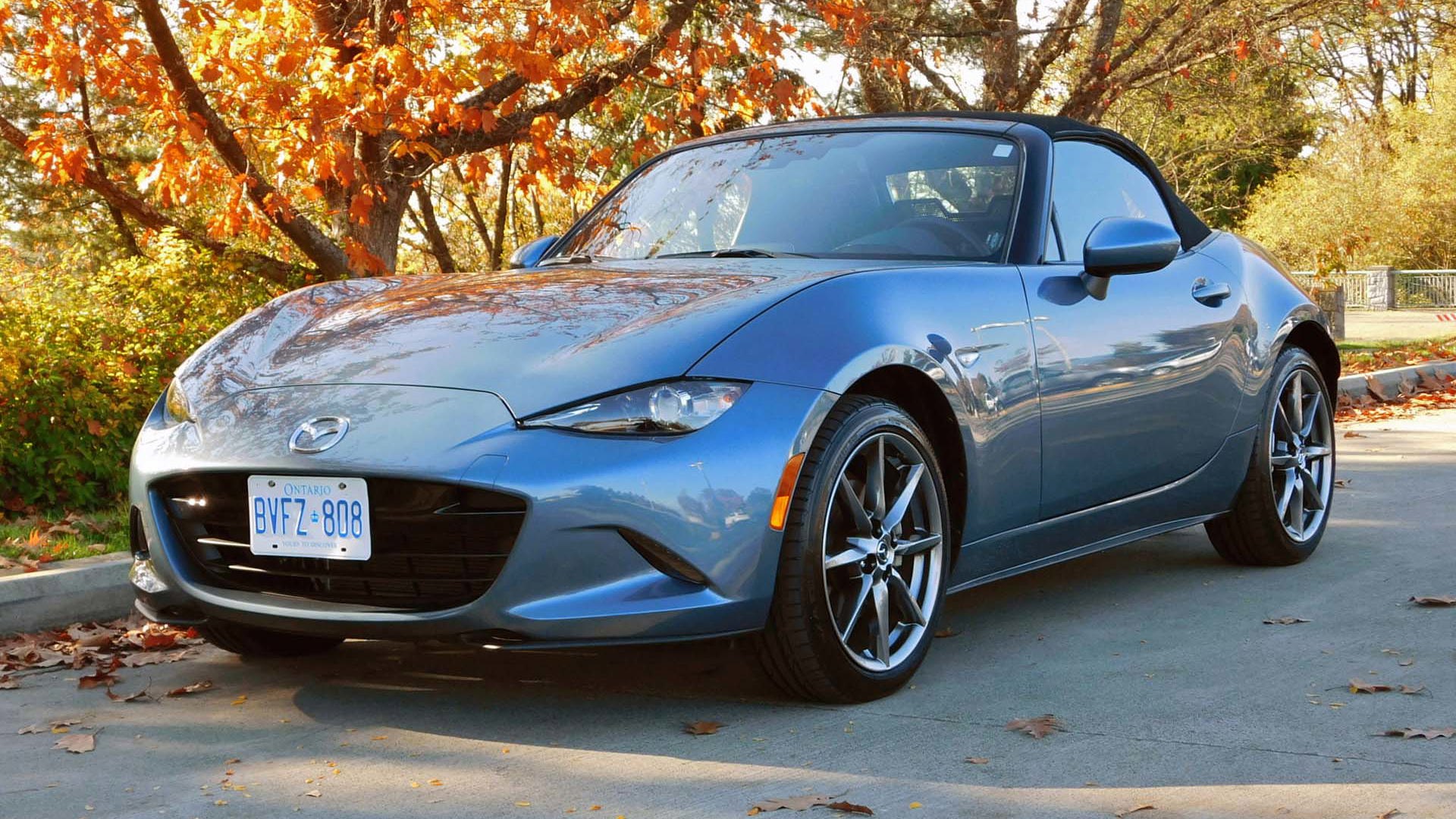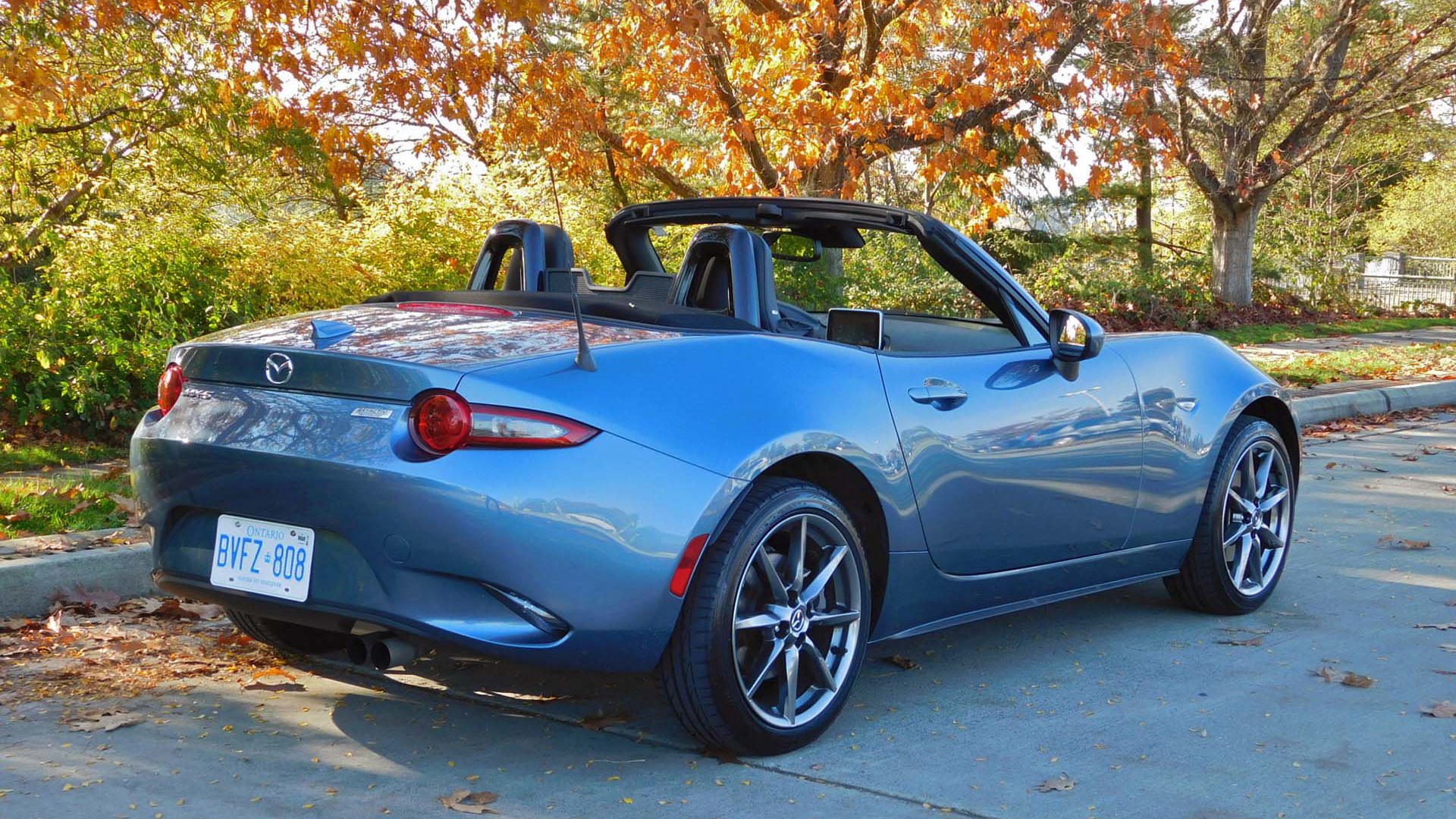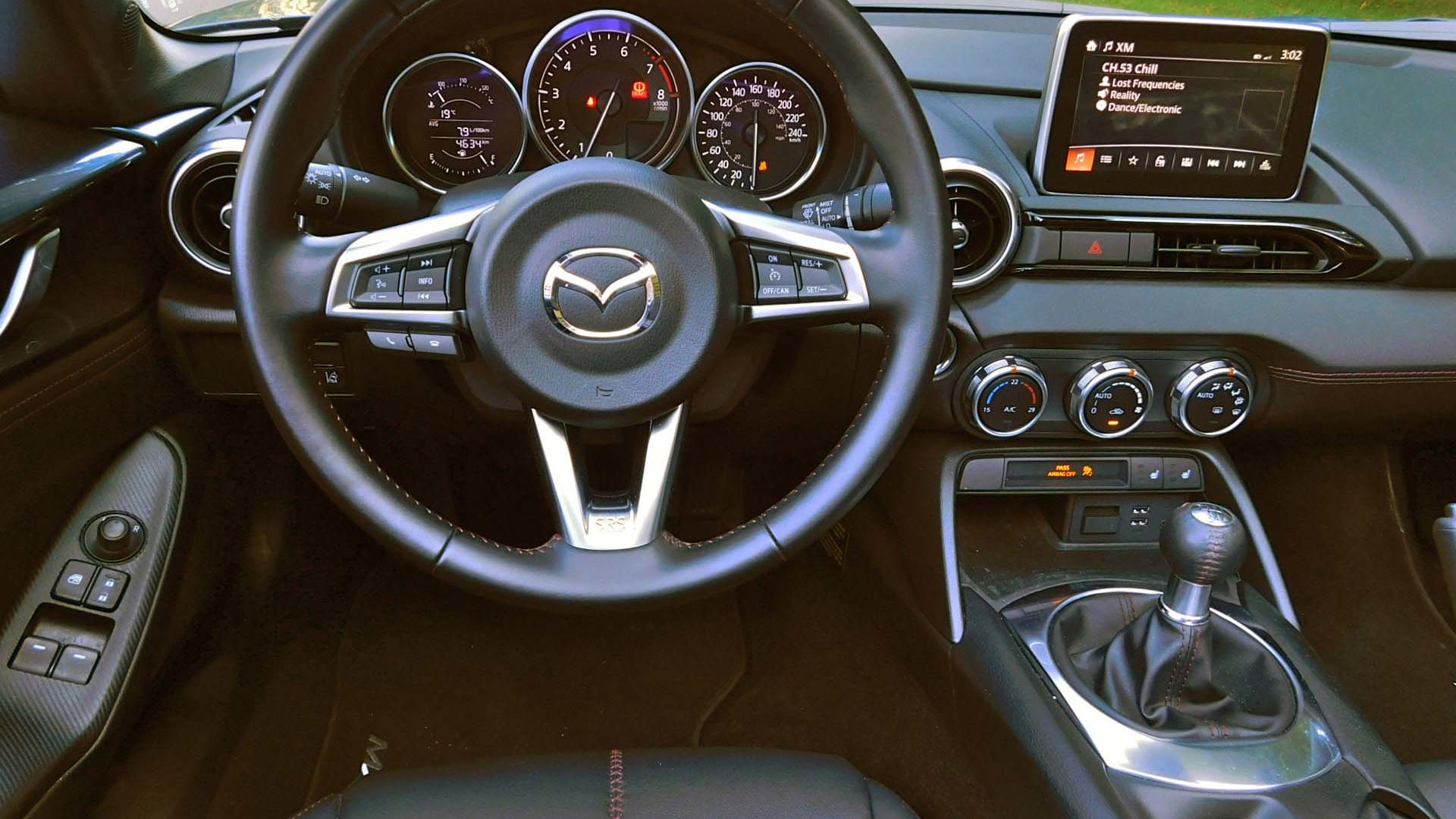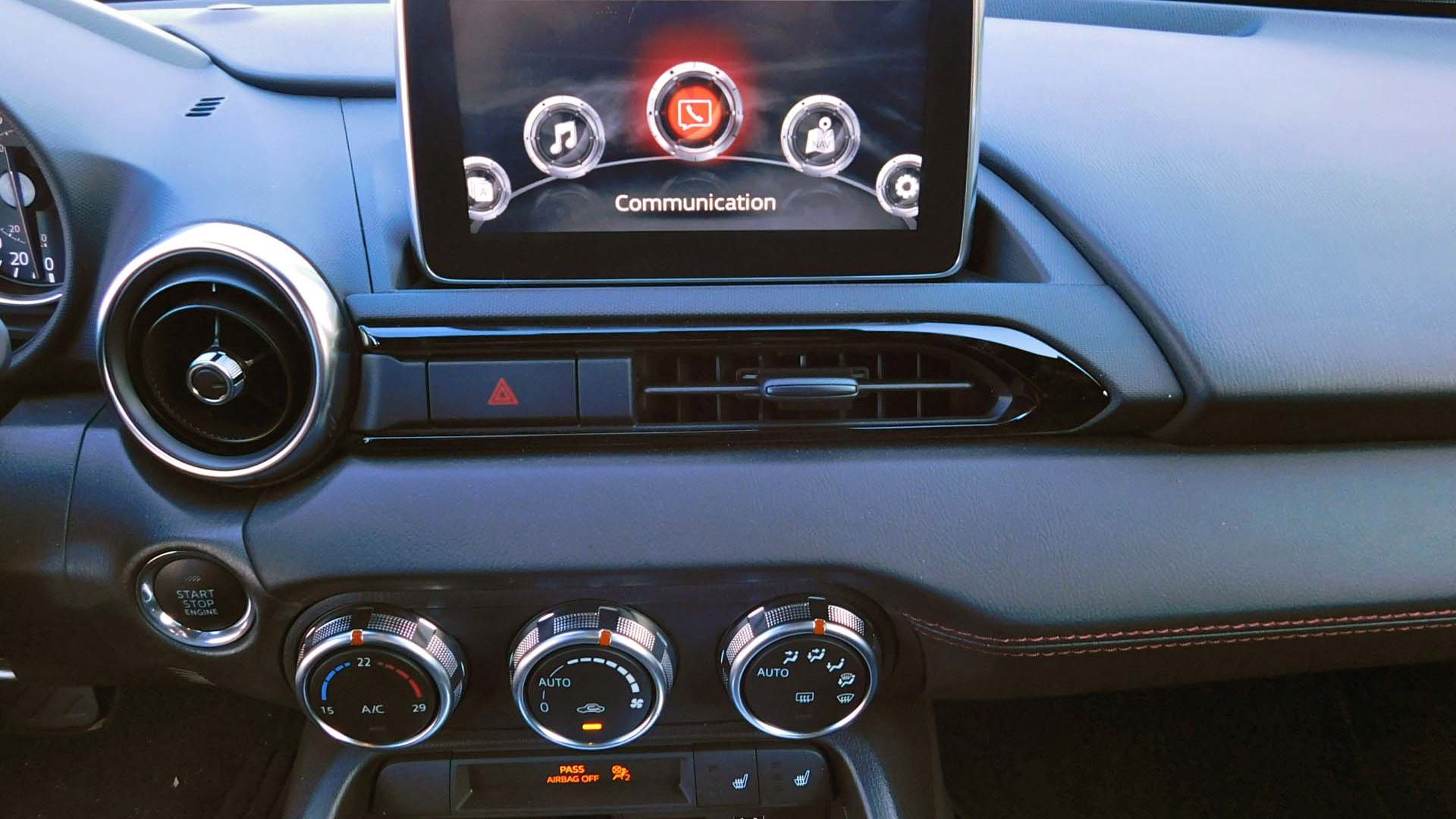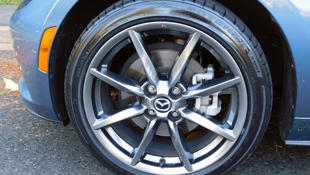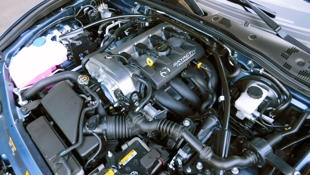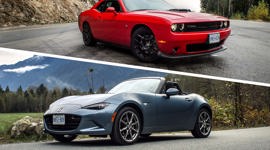 AutoTrader SCORE
AutoTrader SCORE
-
INTERIOR7/10
-
EXTERIOR STYLING8/10
-
FUEL ECONOMY9/10
-
PERFORMANCE10/10
-
COMFORT8/10
Somehow, over the years, cars seem to have lost their joy. Today's hordes of bulky crossovers and over-engineered sedans offer up loads of comfort, abundant technology, and ever-increasing levels of performance, but seldom any driver engagement or fun – unless you think clicking shift paddles and listening to fake engine noise counts as fun.
This is a car that can make driving across a parking lot fun.
Thankfully, the folks at Mazda having been busy scooping up all the lost joy and bottling it in the cellar of their engineering department. And for 2016, they've distilled it into concentrated format and released it in the form of the all-new fourth generation MX-5. If you think cars are just appliances for getting from A to B, or that "They don't make them like they used to anymore," it's only because you haven't yet driven Mazda's little joy buzzer of a roadster. This is a car that can make driving across a parking lot fun.
The MX-5 has been fulfilling the same basic mission of bringing rear-wheel-drive roadster joy to the masses since its introduction as a 1990 model (initially called the Miata here in North America), and while you couldn't really accuse the second- and third-generation versions of bulking up or going overboard with options and technology, for this fourth-generation redesign Mazda has applied its SkyActiv technology and Kodo "Soul of Motion" design language to lighten the MX-5, resharpen its focus, and give it a new sense of style.
Gone is the cartoonish grinning grille, replaced by a more purposeful-looking and steeply sloped front end featuring squinty LED headlights and swooping fender arches. At the back, round taillights cut by blade-like extensions echo the headlights. Styling is always subjective, but to my eye the overall look nails it, with just the right blend of athleticism and approachability, and my Blue Mica–painted test car certainly drew lots of positive comment.
Under the restyled skin the engineers have shaved off an impressive 100 kg or so of weight, stiffened up the structure, ditched the optional power hardtop, and tweaked the chassis for improved seat-of-the-pants feel. The manually operated soft top features a rigid forward header panel and single central twist-latch, and it operates quickly and easily with one hand. I've got an injured rotator cuff thanks to a skiing wipeout last season, so I needed to take a little care when twisting and reaching behind me to operate the top, but even so I was able to stow and deploy it in a couple of seconds flat, even when moving along in slow traffic (the owner's manual says to stop the car and operate the top while standing beside it, so don't tell Mazda I did this!).
Head-to-head-to-head: 2016 Mazda MX-5 vs 2015 Scion FR-S vs 2015 Ford Mustang
Power for the new MX-5 comes from a retuned version of the same 2.0L SkyActiv four-cylinder engine that's found in the Mazda3. Here it produces 155 hp and 148 lb-ft of torque when running on the recommended (but not required) premium fuel. That's a little less horsepower than the old engine but a good dollop more torque: With only 1,078 kg of weight to propel (in GT trim) and with the torque coming on strong early in the powerband, the engine feels plenty peppy and it whips the MX-5 forward with a lusty growl (a lot of that is induction noise rather than exhaust noise, but none of it is faked). Zero to 100 km/h takes about 6.5 seconds, which is quick enough to be fun yet not so ridiculously fast as to deny you the pleasure of properly burying the accelerator pedal on occasion.
Fuel economy is rated at an impressive 8.8 / 6.9 L/100km (city/highway), and my test car was showing a long-term average of 7.6 L/100 km when I first picked it up. I didn't do quite that well myself, since I was having far too much fun tearing around the city using generous applications of throttle, but even then I still didn't do much worse than the official city figure, with a recorded consumption of 9.6 L/100 km.
Transmission choices include a standard-equipment six-speed manual transmission or a no-cost optional six-speed automatic with paddle shifters. The automatic is a suitable choice if you have a serious left-leg injury that prevents you from operating a clutch, but otherwise you should do yourself a favour and go with the manual, as it really is more suited to the car's back-to-basics character (and if necessary you can sign up for standard-shift driving lessons to get you started). The six-speed manual, as fitted in my test car, has short gear throws and it snicks through the cogs with delightful ease. The clutch is likewise light and easy to modulate, so not even stop-and-go traffic presents much of a chore.
One engineering concession to modern times in the fourth-generation car is the inclusion of a fuel-efficient electric power steering system in place of the MX-5's previous hydraulic setup. However, while many such systems mount the assist motor on the steering column, Mazda has mounted it on the rack to more closely duplicate the feel of a traditional hydraulic setup. I found that it provides decent enough steering feel to keep you attuned to the road and the tires, so while I didn't get a chance to compare it back-to-back with a previous-generation MX-5 (and I imagine the car could probably get along fine without power steering at all) I'll give the setup a passing grade.
Inside, the new MX-5 steps up the game significantly compared to the previous-generation car, certainly in terms of materials and style. Mazda's designers have held the car's overall exterior dimensions to within a few mm of the first-generation car (it's actually a touch shorter and wider), so while they've done an admirable job of carving out a few mm of extra cabin space here and there, don't expect a lot of extra lounging space or room for stuff. At 5'11" and 160 pounds I found the car a perfect fit, like the proverbial glove. Drivers much over six feet, on the other hand, will certainly want to check for fit before plunking down their dollars.
The armrests and console top are nicely padded, which takes care of the major touch points, and the rigid plastics used elsewhere all look good, with nice textures and low sheen. The gauges are big, clear and easy-to-read, and the key tachometer and speedometer remain thankfully analog. Overall, the effect is much improved over previous-generation MX-5 cockpit, and my GT test car added a big helping of luxury with contrast-stitched leather upholstery to match its leather-wrapped steering wheel, gear knob and park brake lever.
There's no actual glove box, although there's a lockable cubby between the seatbacks. Cupholders are installed here too, where they will indeed hold your drinks but where retrieving said drinks requires interesting contortions (Mazda's engineers have been quoted as saying it was a choice between making it awkward to reach your drink, or awkward to shift gears, and the gear shifting was prioritized). There's a slot in the transmission tunnel to allow you to move one of the cupholders to the base of the console where it's convenient to reach but takes up some of the passenger's leg room. Squeezed in behind the cupholders is the CD changer, and there's a shallow console bin that'll fit spare change and a cell phone.
Like the interior storage, the trunk is small (only 130 L), but it'll hold as many bags of groceries as a couple can reasonably hand-carry out of the supermarket (enough for the whole week, I found – see the smartphone photo in the gallery) and I even managed to fit the #1 genoa for a 36-foot sailboat in there, so provided you go with soft luggage a couple of small bags for a weekend out shouldn't be a problem.
In terms of infotainment, my test car was fitted with Mazda's Mazda Connect system featuring a 7-inch colour touchscreen perched in the now-familiar position atop the dash. The system is reasonably easy to use (I did make a couple of missteps when first connecting my phone, but quickly got used to the interface) although the navigation graphics are perhaps a little crude. My one real complaint is that due to the positioning of the HMI controller on the console behind the gearshift lever, there's a tendency accidentally activate it with your forearm when shifting gears.
On the bright side, the Bose nine-speaker Centerpoint audio system in my GT test car was miles ahead of the systems in previous-generation MX-5's I've driven, with real presence and clarity even when moving along at a decent clip with the top down. A pair of USB ports, an auxiliary plug, HD radio, satellite radio and MP3 compatibility ensure plenty of input options in addition to the traditional AM/FM and CD.
The MX-5 GT also now includes a blind-spot monitoring system, and while generally I'd prefer Mazda not put too many electronic nannies aboard the MX-5, I did appreciate this particular assist device when driving with the top up (rearward visibility with the top up is actually pretty good by convertible standards, but as with all soft tops there's a decent-size blind spot formed by the roof's sides).
On the road the MX-5 feels frisky and light on its feet, and there's enough torque on tap that you're never really caught flat-footed even if you're in too high a gear. The car is also tremendously connected, and I'm not talking here about being well integrated with your smartphone – yes, the MX-5 does connect to your gadgets, but more than that it connects to the driver. So while the tail will break loose fairly readily if you push hard in the corners (and the stability control system gives the car some leeway before reining it in) I found that I could feel the car's rotation so clearly through the driver's seat that I typically had the car back in line (with a big grin on my face) well before the electronic nannies had to act.
Everything else, too, provides excellent feedback and intuitive control – the brakes, the steering, the throttle, all perfect. Mazda calls this connectedness jinba ittai ("rider and horse as one body"), and it has been a prime directive in the MX-5's development over several generations. The good news is they got it absolutely bang-on in this latest-generation car: the new MX-5 is an absolute hoot to drive, and the view down the hood, with it's twin fender bulges, only adds to the pleasure.
With the possible exception of the front-wheel drive Mini Convertible, there currently aren't any direct competitors for the MX-5 – what competitors there are either lack the MX-5's convertible top (like the Scion FR-S and Subaru BRZ coupes), or cost significantly more than the Mazda (like the Nissan 370Z Roadster, BMW Z4 Roadster, Porsche Boxster, BMW 228i Cabriolet and Audi A3 Cabriolet). For 2017 we can look forward to seeing Fiat's 124 Spider on the market here – itself based on the Mazda's platform – but in the meantime if you want what's arguably the purest expression of the driving experience available for the mass market, the MX-5 is the only game in town.
| Warranty: 3 years/unlimited distance; 5 years/unlimited distance powertrain; 7 years/unlimited distance corrosion perforation; 3 years/unlimited distance roadside assistance Competitors: |
| Model Tested | 2016 Mazda MX-5 (GT Trim) |
|---|---|
| Base Price | $39,200 |
| A/C Tax | 100 |
| Destination Fee | $1,795 |
| Price as Tested | $41,095 |
|
Optional Equipment
None
|
|
